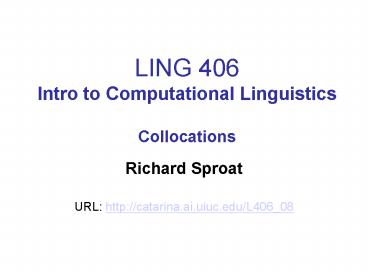LING 406 Intro to Computational Linguistics Collocations PowerPoint PPT Presentation
1 / 32
Title: LING 406 Intro to Computational Linguistics Collocations
1
LING 406Intro to Computational
LinguisticsCollocations
- Richard Sproat
- URL http//catarina.ai.uiuc.edu/L406_08
2
This Lecture
- What are collocations?
- Measures of association
- Pointwise Mutual Information
- Frequency-Weighted Mutual Information
- Pearsons 2
- Dunnings likelihood ratios
- Non-binary collocations
3
Some characteristics of collocations
- Firth (1957) Collocations of a given word are
statements of the habitual or customary places of
that word - In plain English collocations are expressions
constructed out of two or more words that have
some special property - Non-compositionality kick the bucket, white wine
- Non-substitutability kick the pail, yellow
wine - Non-modifiability kick the big bucket, very
white wine
4
Some kinds of collocations
- Idioms kick the bucket, red herring
- Nominal compounds dog catcher, brown bread, sump
pump, white wine - Verb particle constructions give up, bowl over,
chew out
5
Why care?
- Lexicography
- Machine translation
- Word segmentation
- Sense disambiguation
6
Simple frequency NY Times Newswire 1990 (4
months)
7
Simple frequency Justeson-Katz filtration
8
Statistical approaches to binary collocations
- Frequency in and of itself doesnt tell you that
words are particularly associated with each
other if both words are frequent you might
expect their combination to be frequent just by
chance. - Statistical measures of association can give an
estimate of how much more likely than chance a
given combination is.
9
(Pointwise) Mutual Information
- Mutual Information was originally proposed as an
information-theoretic measure of channel capacity
(Fano 1961).
10
1995 AP Newswire Collocations
11
1995 AP Newswire Non-Collocations
12
Problems with mutual information
- It is unreliable for small counts. (But this is
really a problem with the MLE)? - The second, and more serious problem is that
mutual information relates to estimated
probability in a counterintuitive way
13
Frequency-weighted MI
14
1995 AP Newswire collocations
15
Problems with Frequency-Weighted Mutual
Information
- Main problem is that it tends to overreward
frequency
16
Pearsons ?-square
17
Pearsons ?-square
18
1995 AP Newswire collocations
19
Problems with ?-square
20
Dunnings (1993) likelihood ratios
n! / (n-k)!k!
21
1995 AP Newswire collocations
22
Problems with likelihood ratios
23
Some Chinese examples MI
24
Weighted mutual information
25
?-square
26
Likelihood ratios
27
Errors on top 500 by each Measure (10
MillionCharacter ROCLING Corpus)
28
Extracting non-binary collocations
29
Smadjas 1993 Xtract
30
Smadjas 1993 Xtract
31
Smadjas 1993 Xtract
32
Summary
- Various statistical measures of collocation
- Each has their advantages and drawbacks
- Collocations are useful in a number of areas,
which well turn to next

